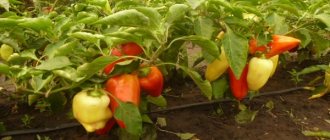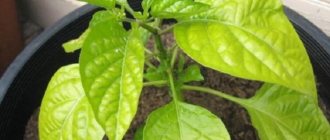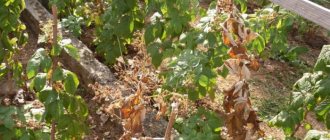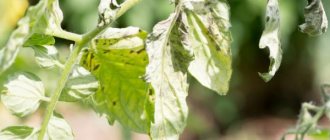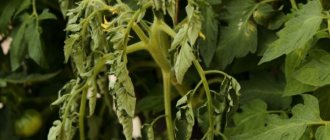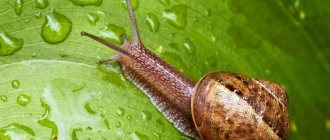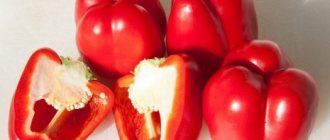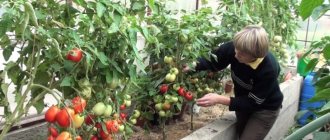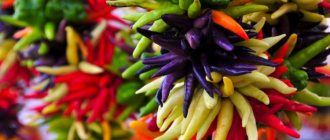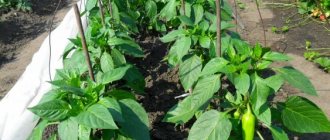Symptoms and causes
Problems can arise at any stage of pepper growth and development. If a plant feels a lack of something, it immediately manifests itself in an unfavorable way on its root system, stem, leaves, flowers, and fruits. That is, if the pepper has produced flowers, this is not at all a guarantee that there will be a rich harvest. For example, the seedlings were good, without any special problems, but after planting in the ground, the flowers and leaves of the seedlings fall off. Symptoms of possible shedding of buds and ovaries may include:
- weak root system of seedlings;
- too sprouted green mass;
- dull, weak leaves;
- transparent cobwebs on pepper leaves;
- the presence of other stress factors.
Note!
Such problems arise mainly in peppers that grow in a greenhouse. If the bell pepper began to shed its inflorescences and ovaries, then the following could happen:
- the emergence of diseases and pests;
- lack or excess of fertilizer masses;
- humidity less than 60%;
- increased air temperature (temperatures above +23C are detrimental for seedlings, and above +26C for an adult plant).
- harmful weather conditions (drought, constant rain);
- lack of pollination;
- indiscriminate watering.
If any of the above conditions are not met, the pepper sheds its flowers or ovaries.
Too bright or insufficient lighting
Poor lighting is a common cause of flowers and ovaries falling off in peppers, especially in greenhouse conditions. Pepper seedlings suffer especially from shortages because they do not absorb nutrients well. Under such conditions, seedlings:
- grow weakly;
- stretch upward;
- give a small harvest.
The ideal length of daylight for full development is 12 hours. In addition, even if such a plant blooms, there is still little chance of a harvest. Insects do not like shade, and therefore are unlikely to pollinate the plant, and without this the crop will not bear fruit. The flowers will fall off and the ovaries will not form on the pepper bush.
You may be interested in:
Sweet pepper seeds - the best varieties for the Moscow region for open ground and greenhouses Sweet pepper is a type of popular annual plant belonging to the Capsicum genus and the Solanaceae family. Vegetable…Read more…
However, excessive lighting will have the effect of overheating the peppers in the greenhouse, which also has a detrimental effect on the growth and development of garden crops.
High temperature
The favorable temperature for pepper seedlings is considered to be +20-22°C. Mature plants are more resistant to temperature fluctuations; for their growth and development, a decrease in the level of the mercury column by 5-7°C is allowed. However, if the temperature drops below this level, there is a risk of loss of ovaries.
Note!
Increasing the indicator to 30°C can have a bad effect on the quality of pollen, and the ovaries of peppers also fall off.
An increase in temperature to 35°C or more can not only cause the ovaries to fall off, but also destroy the vegetable.
Insufficient humidity level
Air humidity is an important condition for favorable growth and development of the crop. 60-80% is considered optimal for pepper. If the plant lacks moisture, it becomes more difficult for it to absorb beneficial microelements, it will dry out and eventually die.
Peppers are capricious to lack/excess moisture:
- If there is a deficiency, the plant will dry out due to lack of oxygen.
- If there is an excess, it will stop growing due to accumulated salts in the soil.
To stabilize the humidity level in greenhouse conditions, it is necessary to ventilate the room more often. Irrigation must also be systematic and sufficient. You can spray water over the peppers using a sprayer or other device, or simply water the beds with a watering can.
Harmful insects and diseases
Rarely, the cause of death of peppers is the appearance of harmful insects and diseases. Usually it comes to this in the most advanced cases, when the vegetable is practically not cared for.
All the plant’s strength is spent fighting infections, diseases, and insect pests, so it sheds excess load in the form of flowers and growing peppers. Peppers can usually be attacked by spider mites or greenhouse whiteflies.
Pepper is susceptible to fungal and bacterial diseases:
- Verticillium or Wilt. Caused by the activity of two types of pathogenic fungi that enter the root system, causing withering and rotting of the crop.
- Bacterial spotting. The appearance of dark spots covering the leaves. They interfere with the process of photosynthesis, slowly destroying the plant.
- Late blight. A disease caused by the activity of fungi, as a result of which the plant becomes covered with brown spots and loses its reproductive abilities.
- Phytoplasmosis or stolbur. A disease caused by the activity of microorganisms. It is introduced into the plant by insect pests. Leads to complete drying of the plant. There are no resistant varieties to this disease.
- Cladosporiosis. A fungal disease that most often occurs in vegetables growing in a greenhouse under conditions of high air humidity.
Improper soil fertilization
If there is a deficiency of essential nutrients and microelements in the soil, the plant loses immunity to disease, weakens, and slows down its growth and metabolism. This leads to the fact that the pepper does not bear fruit.
Attention!
When experiencing a stressful situation, the bush takes off the extra burden in the form of flowers and ovaries.
The most important microelements for pepper are:
- nitrogen – necessary for the proper formation and development of stems and green mass;
- potassium – increases the endurance of the pepper bush to temperature changes, promotes the ripening of peppers;
- phosphorus - makes roots stronger, promotes the formation of ovaries.
It's easy to make a big mistake in fertilizing peppers, knowing how capricious they are. Gardeners often overfeed the soil, which is just as bad for this plant as underfeeding. Excess nitrogen is especially harmful; because of this, the vegetable grows into a stem, a green mass, which prevents it from blooming and bearing fruit. With an excess of potassium and a lack of phosphorus, a large mass of ovaries may appear, which will subsequently fall off. There are too many fruits, the level of phosphorus in the plant will not support such an amount.
A lack of nutrients can be confused with the manifestations of a disease, but experienced farmers can easily identify the problem.
| Soils | Lack of microelements | Manifestation |
| Light sandy or sandy loam | Iodine, potassium, magnesium, bromine, sulfur | A yellow border appears on the leaves, the green mass becomes stained and dries out, the pepper does not bloom |
| Carbonate or re-calcareous | Manganese, boron, zinc | The leaves do not grow, remain small and curl. The growth of stems and roots stops, the plant does not bear fruit. Pepper seedlings' flowers fall |
| Peat | Copper, potassium, boron, manganese | The plant grows poorly, loses green mass, does not bear fruit |
Planting density also affects the proper growth and development of the crop. Many gardeners believe that the denser the pepper bushes are planted, the more harvest they will bring. In fact, peppers placed closely together begin to compete for nutrients in the soil. Thus, some bushes receive useful microelements, while others experience starvation, which is a stressful factor and can lead not only to the fall of the ovaries, but also to the death of the bush.
Attention!
The ideal planting density in greenhouse conditions is 3-6 bushes per 1 m² (depending on the size of the bush). This way, the roots will not lack nutrients, and the leaves will receive the necessary amount of air mass to prevent various diseases.
Chapter 4. Video
Healthy seedlings are the key to an excellent harvest, but what if the leaves of the peppers fall off? This fact indicates that not everything is in order with the plants; you need to look for reasons and ways to eliminate leaf fall.
Pepper leaves are falling: looking for the cause
I grow peppers in the garden every year, and somehow I encountered the problem of leaves falling. It happens that peppers lose leaves at the seedling stage or when planting in a greenhouse and placing plants in the garden. Sudden leaf fall in a vegetable can begin on any day, regardless of the month.
I discovered that completely healthy pepper seedlings began to shed leaves for no apparent reason and began to figure it out.
So, peppers can shed leaves for a variety of reasons, namely:
- If seedlings are grown in poor soil or worse, in untested purchased soil;
- A shadow hangs over the pepper plantings;
- Trees with a powerful root system were planted nearby;
- Plants are favored by pests, aphids or thrips;
- The seedlings were placed on the bed without preliminary hardening, and no shading was created from the sun's rays;
- The plants were watered with cold water, and one-time watering was sufficient;
- Drops of cold condensation falling on the leaves;
- Too dense placement of plants at the seedling stage.
How to prevent peppers from defoliating leaves
An alarming phenomenon - leaf falling, can be prevented, it is only important to notice the plant disease in time. Knowing that pepper has a negative attitude towards crowding, I arrange the pickled vegetables freely to avoid excessive thickening
Knowing that pepper has a negative attitude towards crowding, I arrange the pickled vegetables freely to avoid excessive thickening.
Before transporting them to the dacha, I spray the seedlings with HB-101 solution to reduce stress from changing conditions. I repeat spraying before planting seedlings.
In order for the plants to adapt faster, I carry out special hardening. To begin with, I take the vegetables outside for a couple of hours, choose windless days, and put the peppers in the shade. I water the peppers first. I am gradually increasing the time the seedlings spend in the air.
Before planting, I water it abundantly and be sure to shade the seedlings for a couple of weeks.
I prepare the soil fertile, adding compost or humus. When growing vegetables in a greenhouse, I change the top layer of soil annually and, if possible, throw snow into the greenhouse in winter.
Spider mites actively multiply in the greenhouse due to the dry air, so as a preventative treatment, I spray the peppers with a solution of karbofos or kleschevit once every two weeks.
An infusion of tomato tops or garlic cloves will help against aphids.
When planting in a garden bed, I maintain a distance between plants of 30-40 cm, depending on the power of the variety.
When the leaves fall heavily, I water them with a solution of sodium humate or spray the leaves with an infusion of herbs; this method is the fastest way to saturate the plants with nutrients.
After watering, I try to prevent the root system from being exposed - I immediately mulch with humus.
If leaves fall for no apparent reason, I pay attention to watering, the soil should be evenly moistened, pepper does not tolerate dryness or, on the contrary, waterlogging
How to please a pepper
It is much easier to initially prevent pepper leaves from falling off than to fight this phenomenon.
Before planting, I prepare nutritious soil with a neutral reaction, to achieve this, I add ash and bone meal.
Timely fertilizing helps me grow healthy plants. The first is nitrogen-based, I use an infusion of herbs, the second is a combined one, it is ash and an infusion of herbs, the third is a complex one, two tablespoons of fertika per bucket of liquid. For irrigation with water and fertilizers, I choose only warm water; for convenience, I place a water barrel in the greenhouse.
It happens that peppers shed their leaves due to excessive dryness and heat, then I attach non-woven fabric under the ceiling of the greenhouse, usually I do this in July.
I talked about why black leaves appear on peppers and how to protect yourself from this phenomenon.
Often in the middle of summer you can hear complaints from neighboring summer residents that the ovaries of peppers are falling off. If nothing is done, the future harvest could be seriously damaged. Let's try to analyze step by step the main reasons for what is happening.
Measures to combat the problem
To ensure a good harvest, it is necessary to strictly monitor the conditions created for the plant. Pepper needs to provide the necessary nutrition, lighting, humidity level, and systemic watering. An experienced farmer should be able to adjust these conditions when growing crops in a greenhouse.
There are methods, tested by time and by farmers, that help correct unfavorable agrotechnical or natural factors.
| Method | Description |
| Landing method | If you use the row or checkerboard planting method, you will get sufficient planting density. This factor is especially important for greenhouse conditions. With this method, the bushes will receive a sufficient amount of light and air, the stalk will become healthy |
| Creating a shadow | During the heat or scorching sun, you can use any means to create a shadow effect. For example, plant a taller crop around the pepper bushes - tomatoes, beans or peas |
| Phytolamp | If the weather is cloudy and there is little sun (you need 12 hours of sunlight), you can use an additional light source - a phytolamp, the bushes will bloom more actively |
| Watering | Irrigation in hot weather conditions should be done once a week, but watering should be plentiful. After watering, it is necessary to loosen the soil so that oxygen enters the root system. It is necessary to irrigate in the morning/evening to avoid direct sunlight, otherwise the shoots will fall before flowering |
| Artificial humidity | To create optimal conditions for the humidity factor in dry weather, you can install special spraying devices. In the greenhouse, it is enough to spill water along the paths around the bushes. Be sure to ventilate |
| Mulching the soil | Soil mulching is covering the soil around a planted plant with a special mulch, which helps protect the soil from overheating and drying out. |
| Feeding mode | The plant's need for fertilizer mixtures must be assessed directly by the condition of the bush. You can feed once every 2 weeks, alternating mineral and organic composition. If there are obvious signs of nutrient deficiency, you can feed additionally. |
| Feeding periods | At the stage of flowers appearing on the bushes, the plant needs more nitrogen fertilizer. The stage of the appearance of ovaries requires more phosphorus and potassium from plants |
| Stopping feeding | If the green mass of the bush is quite thick, and the plant begins to shed flowers and ovaries, this means that fertilizing needs to be stopped. Oversaturation with minerals is not recommended |
To combat insect pests, you can use biological and chemical preparations:
- Aktara;
- Actellik (whitefly);
- Kleschevit (spider mite), etc.
You may be interested in:
How to determine when to pick peppers after germination? Pepper seeds sown at the end of winter and beginning of spring soon sprout, and then the seedlings face important agrotechnical...Read more...
The use of powerful drugs will be necessary if there are large losses of potential yield. Of course, it is better to first try to solve the pest problem with folk remedies. For example, spray with infusion of chamomile, garlic, yarrow or a solution made from laundry soap.
What to do if pepper ovaries fall off
On poor, depleted soils, peppers often form defective ovaries that do not stay on the branches for long. This culture prefers light, humus-rich soil containing all nutrients in a bioavailable form.
Nitrogen is of particular importance in the nutrition of peppers: the normal development of all vegetative organs - leaves, stems and roots - depends on its presence and concentration in the soil.
With nitrogen starvation, the growth of peppers slows down, and with an excess of this element, violent growth of leaves and stems is observed to the detriment of the formation and ripening of fruits. A prerequisite for the formation of a powerful root system in pepper plants is the presence of a sufficient amount of phosphorus in the soil. In addition, this macronutrient accelerates the appearance of ovaries and fruits. Peppers also need a stable supply of potassium to the soil throughout the growing season, as it increases their resistance to cold and stimulates fruit ripening.
Throughout the entire season from the moment of planting the seedlings, it is recommended to feed the pepper once every two weeks, alternately using organic and mineral fertilizers. To prepare mineral fertilizer, 15-20 grams of ammonium nitrate or urea, 40-50 grams of double superphosphate and 20-30 grams of potassium sulfate are dissolved in a 10-liter bucket of water. All of the above types of mineral fertilizers can be replaced with a full complex fertilizer at the rate of 30-50 grams for the same volume of liquid. After a couple of weeks, the bed with this crop must be watered with a solution of organic matter (slurry (1:8), bird droppings (1:15), etc.).
In the future, the above-described feedings are alternated at intervals of 1.5-2 weeks. During mass fruiting of peppers, it is best to fertilize with an infused solution of superphosphate (40 grams per 10 liters of water).
A good preventive measure against ovary drop in peppers is also foliar feeding of this crop with a 0.1-0.2% solution of calcium nitrate. They are carried out twice with a break of a week. The same solution can be used to fertilize plants at the root level at the rate of 1-2 liters per pepper.
In the absence of calcium nitrate, a similar effect can be obtained by adding a glass of chalk suspension under each plant. To prepare it, take one or two tablespoons of chalk per liter of water. In addition, saltpeter can also be replaced with a 0.3-0.4% solution of potassium chloride, which can be purchased at any pharmacy without a prescription.
Preventive measures
The surest way to prevent diseases and all kinds of problems is to create optimal conditions for the proper growth and development of pepper. In greenhouse conditions:
- maintaining cleanliness;
- proper soil preparation;
- disinfection;
- air circulation.
In a greenhouse, the soil potential deteriorates, pathogenic bacteria and fungi appear, so it is necessary to feed the soil even before planting fruit crops on it. In autumn you can use manure as fertilizer. During the winter, the soil becomes saturated, thereby getting rid of harmful pathogens.
Note!
In spring, the soil should warm up 2 weeks before planting; it must be fertilized with humus or mineral fertilizer.
Improper soil fertilization
On infertile land, the fruits will not please you with either quality or quantity, because then defective ovaries are formed. They cannot survive for long: the plant discards them. That's why peppers need soil rich in nutrients.
The nitrogen content in the soil is especially important. Its deficiency leads to slow growth of vegetative organs. Excess leads to too much growth of green mass to the detriment of the development of ovaries, which significantly reduces the number of fruits on the bush. This may even cause the ovaries to fall off.
During the growing season, peppers must be fed with nitrogen-containing fertilizers in strictly defined doses. If an overdose does occur, stop feeding for an average of 2 weeks.
Advice from experienced farmers
Gardeners who successfully grow peppers give the following recommendations:
- pepper practically does not tolerate transplantation, so seedlings need to be sown immediately in separate containers;
- flowers or onions planted nearby can help against harmful insects;
- certain methods of forming bushes can affect the size or number of peppers;
- to improve fruiting, stems and leaves below the first branch can be carefully removed;
- You can pinch the growth points of the bush (the crown of the plant) so that the plant stops growing and begins to ripen the fruit (this method is best used 1-1.5 months before the end of the season).
You may be interested in:
How I prepare seeds from store-bought sweet peppers You can grow a plant from the seed of a vegetable bought in a store, even obtaining a full-fledged harvest. Germination…Read more…
The falling of flowers, formed ovaries and unripe fruits of peppers causes great damage to the harvest. To ensure that the effort spent on growing bell peppers (and a lot of it needs to be put in) is not wasted, it is necessary to provide the plant with optimal conditions for proper growth and development. Constantly monitor the condition of the bushes to avoid a lack or excess of nutrients, light, and humidity. Timely and comprehensive support for the plant will help to grow a rich harvest. If everything is done correctly, the plant will not lose color.
Why don't peppers set in a greenhouse?
In closed ground, situations often arise when peppers do not form flowers, and even if they bloom, they do not set fruit.
To save the harvest, you need to understand the reasons. The formation of barren flowers is influenced by many factors - lack of potassium and boron, low and high temperatures, agricultural errors. These reasons need to be identified and eliminated.
Plants bloom, but there are no ovaries or fruits
If pepper grown in a greenhouse blooms on time and abundantly, but without the formation of an ovary, then the main reason is the sterility of the pollen.
Why there is a problem with the formation of ovaries:
- significant temperature changes between day and night;
- the greenhouse is not ventilated due to rainy or cold weather;
- low light level, short daylight hours;
- lack of potassium and boron in the greenhouse soil - if there is a lack of these elements, the ovary does not form or immediately falls off;
- excessively humid air in a greenhouse makes pollen moist and heavy - in this state it cannot spread throughout the flowers;
- too warm air in the greenhouse, above 28°C, leads to absolute sterility of flower pollen;
- absence of insects that pollinate flowers.
Prevention
Not all factors influencing the shedding of flowers and ovaries by pepper can be foreseen in time, so preventive measures are very important. Of course, you need to follow all the rules of agricultural technology and crop cultivation, and you can additionally treat the plants with drugs that stimulate flowering and fruit formation. Such products have an additional function - preventing the fall of buds and young ovaries when grown in unfavorable conditions. The most popular and reliable stimulants are Ovary and Bud.
Universal ovary
To treat pepper flowers, the drug is diluted strictly according to the instructions on the back of the package: 2 g are dissolved in 1 liter of water. The treatment is carried out twice: at the beginning of the budding of the crop and at the beginning of flowering. The working fluid consumption will be 0.3 liters per 10 m 2 of plantings.
Bud
Peppers are treated with a 2% solution of the drug: 2 g of the substance are diluted in 1 liter of water. The drug is dissolved in a small amount of water, then brought to the required volume. Spraying is carried out at the stages of budding and the beginning of flowering of the crop.
In order not to damage the pepper flowers, the treatment is carried out in the morning or evening, when there is no scorching sun. During work, be sure to use personal protective equipment (gloves, respirator).
Preventive measures will help prevent the falling of ovaries and flowers, as well as increase the resistance of peppers to unfavorable conditions.
Why the pepper ovary does not bloom or falls off: video
https://youtube.com/watch?v=jxgJnvyUrbY
The massive fall of buds and small fruits that have already formed has a significant impact on the future harvest.
Therefore, it is very important to be able to accurately determine the cause of this phenomenon and try to eliminate it as quickly as possible. Don’t forget about preventative spraying of flowers with preparations that stimulate flowering and fruit formation of peppers.
Pepper has a fairly long growing season, and since this crop is also capricious in terms of growing conditions, it happens that flowers and ovaries fall off even before planting in open ground or immediately after the first flowering. Why do the flowers and ovaries of peppers fall off and what to do, let's figure it out.
